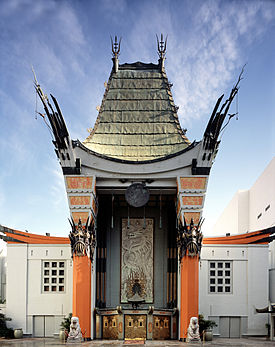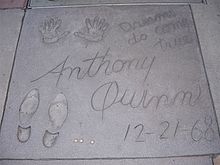TCL Chinese Theatre
From Wikipedia, the free encyclopedia
|
Front entrance facing Hollywood Boulevard
| |
| Former names | Grauman's Chinese Theatre Mann's Chinese Theatre |
|---|---|
| Location | 6925 Hollywood Boulevard Hollywood, California, U.S. |
| Coordinates | 34°6′7″N 118°20′27.5″WCoordinates: 34°6′7″N 118°20′27.5″W |
| Owner | Chinese Theatres, LLC |
| Type | Indoor movie theatre |
| Capacity | 932 (as of 2013)[1] |
| Construction | |
| Broke ground | January 9, 1926 |
| Built | January 16, 1926 |
| Opened | May 18, 1927 |
| Renovated | 2001–2004 2013 (Digital IMAX conversion) 2014(70mm IMAX installation) |
| Website | |
| www.tclchinesetheatres.com/ | |
| Designated | June 5, 1968 |
| Reference no. | 55 |
TCL Chinese Theatre is a cinema palace on the historic Hollywood Walk of Fame at 6925 Hollywood Boulevard in Hollywood, California, United States. OriginallyGrauman's Chinese Theatre and renamed Mann's Chinese Theatre in 1973; the current name of the theatre became official January 11, 2013, after TCL Corporation purchased the naming rights.[2]
The original Chinese Theatre was commissioned following the success of the nearby Grauman's Egyptian Theatre, which opened in 1922. Built by a partnership headed by Sid Grauman over 18 months starting in January 1926, the theatre opened May 18, 1927, with the premiere of Cecil B. DeMille's film The King of Kings.[3]It has since been home to many premieres, including the 1977 launch of George Lucas' Star Wars,[4] as well as birthday parties, corporate junkets, and threeAcademy Awards ceremonies. Among the theatre's most distinctive features are the concrete blocks set in the forecourt, which bear the signatures, footprints, and handprints of popular motion picture personalities from the 1920s to the present day.
The TCL Chinese Theatre has partnered with IMAX Corporation to create the single largest IMAX auditorium in the world. The new theatre seats 932 people, and hosts the third largest commercial movie screen in North America.[1]
History[edit]
After his success with the Egyptian Theatre, Sid Grauman turned to Charles E. Toberman to secure a long-term lease on property at 6925 Hollywood Blvd. Toberman contracted the firm of Meyer & Holler, designer of the Egyptian, to design a "palace type theatre" of Chinese design. Grauman financed and owned a one-third interest in the Chinese Theatre; his partners—Mary Pickford, Douglas Fairbanks, and Howard Schenck—owned the remainder.[3] The principal architect of the Chinese Theatre was Raymond M. Kennedy, of Meyer & Holler.
During construction, Grauman hired Jean Klossner to formulate an extremely hard concrete for the forecourt of the theatre. Klossner later became known as "Mr. Footprint", performing the footprint ceremonies from 1927 through 1957.
Many stories exist to explain the origins of the footprints. The theatre's official account in its books and souvenir programs credit Norma Talmadge as having inspired the tradition when she accidentally stepped into the wet concrete. However, in a short interview during the September 13, 1937, Lux Radio Theatre broadcast of a radio adaptation of A Star Is Born, Grauman related another version of how he got the idea to put hand and foot prints in the concrete. He said it was "...pure accident. I walked right into it. While we were building the theatre, I accidentally happened to step in some soft concrete. And there it was. So, I went to Mary Pickford immediately. Mary put her foot into it." Still another account by the construction foreman, Jean Klossner, recounts that Klossner autographed his work next to the right-hand poster kiosk and that he and Grauman developed the idea then and there. His autograph and handprint, dated 1927, remain today. The theatre's third founding partner, Douglas Fairbanks, was the second celebrity, after Talmadge, to be immortalized in the concrete.
In 1929, Sid Grauman decided to retire and sell his share to William Fox' Fox Theatres chain. However, just a few months later, Howard Hughes convinced Grauman to return to the theatre because he wanted Grauman to produce the world premiere of his aviation epic Hell's Angels, which would also feature one of Grauman's famous theatrical prologues before the film. Grauman remained as the theatre's managing director for the entire run of Hell's Angels, retiring once again after its run finished. But, unsatisfied with retirement, Grauman returned to the theatre as managing director on Christmas Day 1931, and kept that position until his death in 1950.
One of the highlights of the Chinese Theatre has always been its grandeur and décor. In 1952, John Tartaglia, the artist of nearby Saint Sophia Cathedral, became the head interior decorator of the Chinese Theatre as well as the theatre chain then owned by Fox West Coast Theatres. He would later continue the work of Jean Klossner, by recommendation of J. Walter Bantau, for the Hollywood Footprint Ceremonies. Tartaglia performed his first ceremony as a Master Mason for Jean Simmons in 1953, for the premiere of The Robe, the first premiere in Cinemascope. Although replacing Klossner was initially thought to be a temporary job for Tartaglia, his dedication would result in a 35-year career in which he last performed as the Master Mason/Concrete Artist in honor of Eddie Murphy in May 1987, leaving behind one of the greatest legacies in Hollywood.
The Chinese Theatre was declared a historic and cultural landmark in 1968, and has undergone various restoration projects in the years since then. Ted Mann, owner of the Mann Theatres chain and husband of actress Rhonda Fleming, purchased it in 1973. From then until 2001 it was known as Mann's Chinese Theatre. In the wake of Mann's 2000-bankruptcy, a partnership of Warner Bros. and Paramount Pictures acquired the theatre, along with the other Mann properties and the Mann brandname.[5]
In 2000, Behr Browers Architects, a firm previously engaged by Mann Theatres, prepared a restoration and modernization program for the structure. The program included a seismic upgrade, new state-of-the-art sound and projection, new vending kiosks and exterior signage, and the addition of a larger concession area under the balcony. The program began in 2002 and restored the original name—"Grauman's Chinese Theatre"—to the cinema palace. As part of the upgrade, Behr Browers also designed a new Chinese-themed six-plex in the attached Hollywood and Highland mall that continued to operate under the name Mann's Chinese 6 Theatre.[6][3]
In 2007, the CIM Group purchased the land on which the theatre sits for an undisclosed price from the Damon Runyon Cancer Research Foundation of New York and Barlow Respiratory Hospital of Los Angeles. Mann Theatres continued to hold a long-term lease on the venue for movie premieres and continued to operate it as a film house. CIM Group also owns the Hollywood and Highland retail mall, as well as numerous other residential and commercial properties in Hollywood.[7] On May 27, 2011, Chinese Theatres, LLC, a partnership owned by nightclub owner/producer Elie Samaha and producer Donald Kushner, purchased both Grauman's Chinese and the adjacent Mann Chinese 6.[8]
The exterior of the theatre is meant to resemble a giant, red Chinese pagoda. The design features a huge Chinese dragon across the façade, with two authentic Ming Dynastyguardian lions ("heavenly dogs") guarding the main entrance and the silhouettes of tiny dragons along the sides of the copper roof. To the dismay of many historic architecture fans, the free-standing ticket booth, installed in the 1930s, and the left and right neon marquees have been removed—but their absence restores the theatre to its original appearance. The auditorium has been completely restored, along with much of the exterior; however, the wear and tear on the physical structure over the years has caused some of the external décor to be removed, rather than repaired.
The Chinese Theatre hosted the 1944, 1945, and 1946 Academy Awards ceremonies; they are now held at the adjacent Dolby Theatre, formerly known as the Kodak Theatre.[9]
TCL Chinese Theatre continues to serve the public as a first-run movie theatre. Many Hollywood films have had their premieres at the Chinese Theatre throughout its history. Today, premieres are attended by celebrities and a large amount of fans, just as they have been since 1927.
Footprints[edit]
Main article: List of TCL Chinese Theatre handprint ceremonies
There are nearly 200 Hollywood celebrity handprints, footprints, and autographs in the concrete of the theatre's forecourt.
Variations of this honored tradition are imprints of the eyeglasses of Harold Lloyd; the cigar of Groucho Marx; the wands used by Harry Potter stars Daniel Radcliffe, Emma Watson, and Rupert Grint; the facial profile of John Barrymore (reflecting his nickname "The Great Profile"); the legs of Betty Grable; Western stars William S. Hart and Roy Rogers left imprints of their guns. Herbie, a Volkswagen Beetle, left the imprints of his tires. The hoofprints of "Tony", the horse of Tom Mix; "Champion", the horse of Gene Autry; and "Trigger", the horse of Rogers, were left in the concrete beside the prints of the stars who rode them in the movies.
Since 2011, there has been a surge of concrete ceremonies, many of which have been paid for by movie studios for publicity reasons. One of the theatre's current owners, Donald Kushner, acknowledged this and referred to them as mock ceremonies.[10] This influx has been a matter of concern for film buffs and historians, as well as misleading for fans. However, despite the increase of cement blocks, the ones placed within the forecourt are still chosen by a special committee who selects celebrities based on their contributions to Hollywood cinema. Practice blocks, completed inside the theatre before the ceremony, are placed on the walls of the Chinese 6 Theatre lobby, which is also used as an event space.
IMAX conversion[edit]
In April 2013, owners announced plans to convert the original theatre for IMAX, which was started thereafter. The Chinese IMAX has the largest seating capacity of an IMAX theatre in the world. The new 94 ft × 46 ft (29 m × 14 m) silver screen is curved and can be masked for premieres and screening events of non-IMAX films. To accommodate better sightlines and a taller screen, the seating is arranged in stepped rows, descending from street level to the floor of the former basement. The auditorium's decorative walls and ceiling remain unaltered, the existing curtain was extended, decorative lighting effects were added and TCL added digital signage. The theatre reopened on September 20, 2013, with the IMAX 3D version of The Wizard of Oz. Although opened with only a digital projection system, a 15/70mm projection system was added forInterstellar.[citation needed]
See also[edit]
- Los Angeles Historic-Cultural Monuments in Hollywood
- The Great Movie Ride, a ride built inside a recreation of the theatre at Disney's Hollywood Studios in Walt Disney World
References[edit]
- ^ a b "IMAX at the TCL Chinese Theatre". TCL Chinese Theatres. Retrieved 2014-02-04.
- ^ Verrier, Richard (January 11, 2013). "China firm buys naming rights to Grauman's Chinese Theatre". Los Angeles Times. Retrieved 2014-02-04.
- ^ a b c "Chinese Theatres – History". Mann Theatre. Retrieved 2014-02-04.
- ^ "Today in History: Star Wars Premieres in 1977". Lomography.com. May 25, 2011. Retrieved 2014-02-04.
- ^ "Studio Partnership Buys Mann Theatres". Los Angeles Times. January 13, 2000. Retrieved 2014-02-04.
- ^ "Grauman's Chinese Theatre". Behr Browers Architects. Retrieved 2014-02-04.
- ^ Vincent, Roger (September 3, 2007). "Famed Chinese Theatre is sold". Los Angeles Times. Retrieved 2014-02-04.
- ^ Miller, Daniel (April 28, 2011). "Grauman's Chinese Theatre to Be Sold to Producers Elie Samaha, Don Kushner". The Hollywood Reporter. Retrieved 2014-02-04.
- ^ "Academy Awards, USA". The Internet Movie Database. Retrieved April 17, 2007.
- ^ Kaufman, Amy. "Grauman's Chinese: Movie star prints' futures not set in cement". Los Angeles Times. Retrieved 20 September 2012.






No comments:
Post a Comment